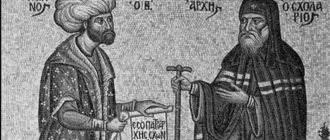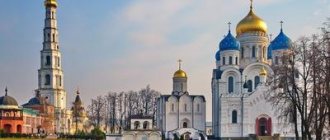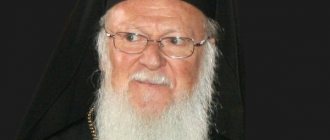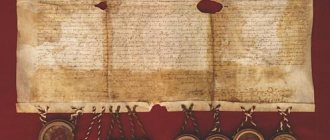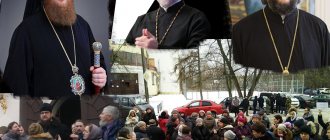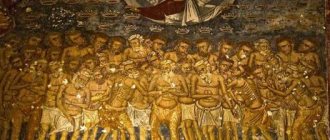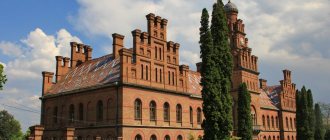Political context
The second quarter of the 15th century was a difficult time in the history of Rus'. Moscow had yet to consolidate its power within the country. In addition, there was no firmly established tradition in Rus' to independently elect a metropolitan. Despite the strengthening of the political independence of the Moscow state, the final word in choosing the first hierarch for Rus' traditionally belonged to Constantinople. And although “in Moscow they wanted to install Ryazan Bishop Jonah as metropolitan, the Patriarch of Constantinople chose Isidore (the last Russian metropolitan from the Greeks). At this time, the Church of Constantinople, in the face of the impending Turkish danger, tried to find help in the Catholic West.
The main cause of Metropolitan Isidore’s life was union with the Western Church. “Proud Romans” in the last years of the Byzantine Empire were forced to seek unity with the Catholic countries of the West. Emperor John VIII Palaiologos and Patriarch Joseph of Constantinople decided to turn to Rome for help. In 1438, the next Council was convened in Ferrara (and then in Florence) with the aim of formalizing the union of the Orthodox Eastern Church with the Roman Church.
For the adoption of the union, or rather, for the subordination of the Eastern Orthodox Church to the Western Catholic Church, favorable political conditions for Rome developed at the beginning of the 15th century. Byzantium was then in extreme danger: its power was limited, in fact, to the walls of the capital alone - all its regions were already in the power of the Turkish Sultan; the troops were few in number and mostly mercenary; the treasury was empty. Emperor Manuel Palaiologos and his son John saw very clearly that the Greeks were absolutely unable to defend themselves from the Turks; they thought that the only way to save the empire was to reconcile with the pope, so that through him they could receive help from Western Christians.
Negotiations continued for more than 20 years. In 1433, the fathers of the Basel Council, which considered itself Ecumenical and acted in the spirit of independence from the pope, invited the Greeks to discuss the reconciliation of the Churches and assured that help could be more accurately expected from the council than from Pope Eugene II, who was then in the very precarious position, while on the side of the Council there were several kings and the German Emperor Sigismund himself. Emperor John, of course, sent an embassy to Basel for preliminary meetings, but he placed greater hopes on the pope.
Literature
- Kargopoltsev, “About Metropolitan. Novgorod Isidore Nikolsky,” Album in Bose of the Deceased Hierarchs
, vol. I, St. Petersburg, 1894. - Lebedev, A., Archpriest, Isidore, Reverend.
Metropolitan St. Petersburg and Lado. , St. Petersburg, 1902. - Zdravomyslov, K. Ya., Hierarchs of the Novgorod diocese from ancient times to the present: Krat.
biogr. essays , Novgorod, 1897, 214-224. - Meletius, archim., Historical.
description Stavropig. first grade Solovetsky convent , M., 1881, 177, 178. - Savva, archbishop, Chronicle of my life (autobiographical notes)
, Serg.-Trinity. Lavra, 1901, vols. II and III; 1902, vol. IV; 1904, vol. V; 1906, vol. VI. - Nikanor (Brovkovich), archbishop, Past life
, vol. I, Odessa, 1913, 106, 231. - Korsunsky, I. N., Eminence.
Isidore, Metropolitan Novgor. and St. Petersburg , M., 1893. - Bertenson, V.B., For Thirty Years
. - Stroev, P., 9, 38, 134, 161, 267, 495, 498, 917.
- Rodossky, A., Slov.
playback St. Petersburg spirit. acad. , 13, 173-176. - Bulgakov, 1399, 1403, 1407, 1409, 1412.
- Denisov, 403, 479, 610.
- Tolstoy Yu., No. 284.
- Church issues in Russia or Russian. spirit. Ved. Braila
, 1896, 45, 48. - Chronicle of E. A.
, 854, 868. - Letters from Metropolitan Philaret
Moscow to the High. persons , Tver, 1888, part I, 21-27, 160, pr. 3; part II, 36, pr. I, 82, pr. 2, 122, pr. 4, 143, 218-219. - Historical-stat.
information about the St. Petersburg diocese , VIII, 74-80. - “Centenary anniversary of the birth of Novgorod. Isidora (Nikolsky) Monastery,” St. Petersburg Spiritual Bulletin
, 1899, No. 34. - Anniversary collection
, 516, 580, 591, 616, 751. - Historical
description Ioanno-Perdtech. m-rya , St. Petersburg, 1907, 21. - Anniversary celebration in memory of fifty years of service in the bishop.
rank of eminent Isidora, Metropolitan Novgorod, St. Petersburg and Finland. Collection , St. Petersburg, 1885. - Lists of bishops
, № 284. - Runkevich, S. G., Alexander Nevsky Lavra 1713-1913.
, St. Petersburg, 1913, 909, 910-915. - Runkevich, S. G., Russian Church in the 19th century.
[Cm.
History of the Christian Church in the 19th Century
, ed. Lopukhina, A.P., St. Petersburg, 1901, vol. II, part I], 647, 672. - Proceedings of K. D. A.
, 1870, June, 15; August, 4; September, 4; 1872, November, 45; 1873, February, 119; 1874, January, 8, 17; August, 424-425; 1875, May, 176; 1877, February, 7-8; August, 118; 1878, April, 44-45; 1882, June, 181; 1886, April, 17-21; 1888, February, 255-256. - Chistovich, I. A., History of the translation of the Bible into Russian.
language , St. Petersburg, 1899. - Warm greetings to Metropolitan Isidore from St. Petersburg.
spirit. acd. , St. Petersburg, 1885. - Right
social security , 1866, January, 50; 1867, March, 198-200; 1898, January, 51; 1899, January, 10; 1904, September, 398; 1907, March, 367. - Church statements
, 1892, № 37, 383-384. - Arr. to Ts.V.
, 1890, № 28, 901; 1891, № 41, 1425; 1892, № 37, 1267-1281; № 38, 1307-1310; 1323-1325; № 39, 1357; 1892, № 8, 282. - Church Vestn.
, 1891, № 3, 90; № 5, 77; № 9, 142; № 16, 255; № 30, 474; № 35, 553; № 36, 572; № 50, 795; 1895, № 33, 1062-1063. - ZhMP
, 1952, № 6, 34-40; 1958, № 9, 13; 1959, № 11, 39. - Rus. fallen
, 1889, № 43, 517; 1895, № 18, 285. - Bulletin of Europe
, 1873, vol. 6, 235. - Wanderer
, 1872, May, 72. - Rukov.
for rural shepherds , 1866, I, 2. - Izv. Kazan. Ep.
, 1870, № 3, 71; 1872, № 5, 129; 1873, № 16, 491; 1883, № 12, 363; 1884, № 22, 721; № 23, 725, 746-750; 1885, № 18, 595-596; № 21, 790-797; 1894, № 19, 596. - Samar. Ep. Ved.
, 1867, № 17, 57; 1869, № 18, 426; 1892, № 19, 826. - Russian antiquity
, 1874, October, 111; 1880, July, 608; November, 703; 1881, December, 704; 1886, July, 64; 1888, January, 7; March, 716; April, 292; 1904, September, 485, 489. - Right
reviewed , 1863, January, 50; March, 117-120; 1864, January, 43; September, 625-631; 1865, December, 129-136; 1866, February, 93; November, 143-144; 1870, January-December, 20, 395-398; 1871, January-December, 572; 1873, January, 65; 1874, January-December, 229-230; 578-579; 1875, September, 140, 145-155; 1876, January-April, 588-589; 1877, September-December, 372-376; 1878, May-August, 385; September-December, 655; 1884, February, 396; May-August, 774-778; November, 625; 1885, November, 417-425; 1886, January-April, 637-640. - N.D., 15, 16, 19, 21, 31, 55, 84.
- Christ.
reading , 1868, May, 728; 1870, January-February, 34-36, 60-73; March, 195-201; August, 71, 76-77; 1871, September, 52; 1872, April, 157; October, 46, 49, 63; 1873, February, 209; April, 243; 1874, February, 240; September, 67, 81; 1875, September-December, 489-556; 1876, November-December, 130-131, 203, 529; 1879, January, 24; July-December, 67, 92-94; 1881, July-December, 90-91, 97; September-December, 140-141, 177, 182, 187, 199-201, 207-208, 267; 1884, June, 41-42; July-December, 479-530; 1885, January-June, 149; 1890, January, 190; May-June, 288. - Histor.
Gazette , 1882, March, 700; 1884, December, 561; 1893, May, 465; 1894, November, 514; 1896, April, 157, 159; June, 801; 1908, January, 271. - Russian archive
, 1887, book. 3rd, 198-199 (“About monuments on the Borodino field”); 1889, book. 1st, 326 (“Field Marshal Prince A.I. Baryatinsky”); book 2nd, 51, 483 (“Letters from Metropolitan Evgeniy Bolkhovityanov to V.G. Anastasevich”); 1893, book. 1st, 400-413 (“Letters from Metropolitan Isidore to Prince A.I. Baryatinsky”); 1895, book. 1st, No. 4, 545; book 2nd, No. 6, 141, 142, 153, 158; 1897, book. 1st, 45 (“From the daily notes of V. A. Mukhanov”); 1899, book. 3rd, No. 12, 549 p/s. 1; 1903, book. 1st, No. 2, 230; book 2nd, No. 5, 95; 1904, book. 2nd, No. 7, 443, 444; book 3rd, No. 9, 69; No. 10, 215; No. 11, 219, 383; 1905, book. 1st, No. 1, 114, 116-117; 1910, book. 1st, No. 1, 101, 104, 107; 1912, No. 5, 140; No. 12, 550; 1916, book. 1st, 150 (“Letter from K.P. Pobedonostsev to Archbishop Hilarion of Poltava, October 5, 1892”). - BEL
, vol. IV, 728-729; vol. V, 1071; vol. X, 609. - BES
, vol. I, 686, 965-966; vol. II, 1582, 1676, 1836, 2108. - ES
, vol. XIII (book 25), 365. - RBS
, vol. VIII, 145-147. - Leskov N. S., PSS
, t. 35, St. Petersburg, 1903.
Who is Isidore?
In 1437, Patriarch Joseph II of Constantinople elevated him to the rank of Metropolitan of Kyiv and All Rus'. The candidate for metropolitan, Bishop Jonah of Ryazan, who was elected by the Prince of Moscow, was forced to be content with the promise that he would be installed on the throne after Isidore. The reason for the hasty installation of Isidore was the need to ensure support for the Kyiv Metropolis and the Moscow Prince for the Council of Florence in 1439. Isidore was an extremely educated man and experienced in negotiations.
Moscow Prince Vasily II the Dark met Isidore with hostility, as if he had been appointed against his will. Being an experienced diplomat, Isidore managed to convince the Grand Duke of the need to convene a new Ecumenical Council, at which the Orthodox would convince the Catholics (Latins) to abandon dogmatic innovations, which would serve to save Byzantium and the Greek Church. Having received money and 100 retinue from Vasily II, Isidore left in September 1437 for a church council in Italy.
Metropolitan Isidore and the Union of Florence - March 19, 1441
March 19, 1441 - Metropolitan Isidore (Greek by origin) returned to Moscow, having signed a union in Florence in the summer of 1439 on the unification of the Orthodox and Catholic churches under the authority of the Pope.
gMoscow Council of 1441 and its significance for world Orthodoxy
By the beginning of July 1439, the Byzantine delegation participating in the Ferrara-Florence Council completely capitulated and declared its agreement to recognize the teachings of the Western Church as true and its readiness to reunite with Western Christians into a single Church. After this, the text approving the union of oros [1] - the main document of the Ferrara-Florence Council - was compiled in two languages, Latin and Greek. On July 5, the oros was sealed with the signatures of the council participants, including 33 Byzantine representatives. Among them was not Metropolitan Mark of Ephesus, who remained true to his position of complete rejection of the Catholic teaching about the procession of the Holy Spirit from the Son, as well as several other Orthodox bishops[2].
Metropolitan of Kiev and All Rus' Isidore, who showed himself to be one of the most zealous supporters of the conclusion of the union, signed it accordingly: “Isidore, Metropolitan of Kiev and All Rus' and representative of the apostolic see of His Holiness Patriarch Dorotheus of Antioch, lovingly agreeing and approving, I sign” [3 ]. The union was also signed by Bishop Abraham of Suzdal: “I will sign the humble Bishop Abraham of Suzdal”[4]. Simeon of Suzdal later assured that Abraham did not want to sign the union, but “Metropolitan Isidore, I put him in prison, and for a full week, and I signed it not because I wanted it, but because I needed it.”[5] Returning to Rus' in 1441, Abraham of Suzdal renounced his signature under the act of the Union of Florence[6].
On July 6, 1439, the union was solemnly proclaimed in the Cathedral of Florence - the Church of Santa Maria del Fiore[7]. The Mass was celebrated by Pope Eugene IV, who was concelebrated by 12 cardinals and 93 bishops[8]. The entire Russian delegation, led by Metropolitan Isidore, was also present at the act of proclamation of the union, during which the emperor, his courtiers, hierarchs and other representatives of the Byzantine delegation, according to Western custom, knelt before the pope and received his blessing[9]. Metropolitan Isidore received generous encouragement from the Pope - on August 17 he received the title of “legate from the side of the apostles” in Lithuania, Livonia, Rus' and Poland. This implied that in all these territories the Russian Metropolitan must implement the decisions of the Ferrara-Florence Council[10]. Soon, Isidore and Vissarion of Nicaea also received cardinal dignity from the pope for their special zeal in concluding the union.
The Russian delegation led by Metropolitan Isidore was also present at the act of proclamation of the union, during which the emperor and other representatives of the Byzantine delegation knelt before the pope.
At the end of the summer of 1439, the Greek participants in the council began to leave Florence. On August 26, Emperor John VIII left for Venice, from where he and most of the members of the Greek delegation traveled by sea to Constantinople. On September 6, the Russian delegation headed by Isidore also went to Venice[11]. Isidore rode to Rus' very slowly[12]. By the end of March 1440, he only managed to reach Krakow[13]. Probably, the Metropolitan was in no hurry, waiting for the first responses to the newly concluded union and intending to act according to the circumstances. In addition, it was important for him to approve the union in the western part of the Russian Metropolis, and meanwhile the King of Poland and Hungary Vladislav III Varnenchik and his brother Grand Duke of Lithuania Kazimir Jagiellonczyk[14], like most monarchs of Europe, sided with the Basel Council, which recognized and most of the Catholic hierarchs of Poland and Lithuania. Eugene IV excommunicated the Basel Council and its participants from the Church, and Isidore was present at this act[15]. These circumstances prevented the establishment of a union in the Western Russian lands, despite the fact that previously the Polish and Lithuanian sovereigns had repeatedly advocated the union of the Orthodox and Catholic Churches.
As early as March 5, 1440, Isidore[16] sent a district message about union to his flock[17]. In it, the Metropolitan announced that from now on Christians of the Latin and Greek rites should enter into Eucharistic communion with each other and have equal rights in the bosom of the one Church. Addressing Roman Catholics, Isidore emphasized the truth of Orthodox baptism. Meanwhile, earlier, at the end of the 14th - 1st half of the 15th centuries, in cases of Orthodox Christians converting to Catholicism, they were often rebaptized by the Polish-Lithuanian Catholic hierarchs, who were distinguished by their radicalism. Therefore, Isidore’s position naturally aroused the discontent of the Catholic Church of Poland, which, right up to the Council of Trent, refused to recognize the legality of baptism performed in the Orthodox Church, and rejected the decisions of the Ferrara-Florence Council, according to which, by submitting to the pope and accepting the union, Eastern Christians could preserve the Greek rite and a separate hierarchy.
Nevertheless, as papal legate, Metropolitan Cardinal Isidore performed divine services according to the Greek rite in Latin churches on the territory of Poland[18]. The Novgorod chronicler also noted that the Russian Metropolitan “ordered the Russian priest to serve his service in the Lyak shrines, and the chaplain in the Russian churches”[19]. Obviously, with such demonstrative actions, the Metropolitan, in defiance of the Polish Catholic hierarchs, wanted to emphasize the equality of the two rites in the bosom of the Church united by the Union of Florence. On the contrary, the Catholic Church in Poland demanded the complete assimilation of Eastern Christians into the Latin tradition. This position of the Polish-Lithuanian Catholics was one of the reasons why they sided with the Council of Basel, which had a similar position, and not Eugene IV and the Ferrara-Florence Council, which advocated the equality of Christians of the Latin and Greek rites in the bosom of a single Church, headed by the Pope. . For this reason, in August 1440, the Latin Bishop of Vilna, Matthew, came into conflict with Isidore, not allowing him to serve as papal legate in Lithuania. The Greeks, who once brought Orthodoxy to Rus', now themselves, led by the patriarch and emperor, have renounced it.
In Krakow, Isidore was nevertheless shown external signs of respect. Archbishop Zbigniew Olesnicki of Krakow received the Uniate metropolitan very kindly; his adviser Jan Elgot gave a speech at the Jagiellonian University in the presence of Isidore, in which he welcomed the conclusion of the Union of Florence[20]. After this, Isidore visited the dioceses of the Russian Metropolis located within the Kingdom of Poland - Kholm and Przemysl[21], for which he appointed new bishops[22]. In August 1440, the Metropolitan Cardinal visited Vilna and other cities of the Grand Duchy of Lithuania, visited Smolensk in the fall, and then went to the southern regions of Rus', which were part of Lithuania.
Probably, by the time Isidore arrived in Great Rus', it was already generally known there about the Union of Florence and the participation of the Kiev Metropolitan in its conclusion, since Abraham of Suzdal, who left him in Vilna, arrived in Moscow on September 19, 1440. It was he who could inform the Grand Duke and to the Russian hierarchs not only about the nature of the concluded union, but also about dissatisfaction with it both on the part of the Greek hierarchs and the Catholic prelates of Poland and Lithuania[23]. It is possible that Vasily II could have other sources of information about the Ferrara-Florence Cathedral, primarily diplomatic.
On March 3, 1441, Metropolitan Isidore finally arrived in Moscow. Before him, as a cardinal and papal legate, they carried the Latin cross[24] and other attributes of his dignity granted to him by Eugene IV[25]. Despite this and knowing about the concluded union, Isidore was allowed to perform divine services in the Assumption Cathedral of the Moscow Kremlin. Most likely, Moscow wanted to thoroughly and slowly understand what happened,
listen to Isidore himself and comprehend his position. It is possible that some element of confusion still existed, and the Kremlin did not yet fully understand how to behave with the Metropolitan after everything that had happened. But still, enough time has passed for Moscow to recover from the shock caused by the first news that the Greeks, who once brought Orthodoxy to Rus', now themselves, led by the patriarch and emperor, renounced it. During the service in the Assumption Cathedral, Isidore, instead of the Patriarch of Constantinople, as was before, commemorated the Pope in the first place. At the end of the service, by order of the Metropolitan, the Oros of the Ferrara-Florence Cathedral was solemnly read out[26]. Isidore also brought the bull of Eugene IV, addressed personally to Grand Duke Vasily II and calling on him to help Isidore in establishing the union[27]. Subsequently, Metropolitan Jonah was “with his seals and with the royal mark”[28]. That is, Moscow received direct evidence that the Byzantine emperor also took part in the conclusion of the union.
The Moscow chronicler reported that immediately after these events the Grand Duke refused to accept Isidore’s blessing and “called him a Latin heretical charmer” and “called him a wolf instead of a shepherd and teacher,” after which he soon ordered his deposition from the metropolis “for he is a mad deceiver and an apostate of the faith.” "[29]. Isidore, by his actions, completely exposed himself as a Uniate, after which the Grand Duke gave the order to imprison the cardinal in the Chudov Monastery[30]. According to the Ermolin Chronicle, Isidore’s imprisonment was preceded by his denunciation as an apostate by Bishop Abraham of Suzdal and Deacon Vasily Karl, after which, on the initiative of the Grand Duke, a Council was held in Moscow, to which Vasily II convened “his land’s bishops, archimandrites and abbots, and all scribe"[31] to consider "Papa's writing"[32] and make a decision on the union. 6 bishops came to Moscow for the Council of the Russian Church to consider the case of the apostate metropolitan: Ephraim of Rostov, Abraham of Suzdal, Jonah of Ryazan, Varlaam of Kolomna, Job of Sarai and Gerasim of Perm[33]. Judging by the fact that Bishop Abraham took part in the trial of Isidore, the Suzdal ruler by that time had already managed to repent for his participation in the conclusion of the union and received forgiveness. At the Council, a discussion about the union developed between the participants of the Council and Isidore: “Having gone against him a lot and outstripping him from the Divine Scriptures”[34].
In the later Nikon Chronicle it is reported that after Isidore’s speech, “all the princes and boars and many others fell silent, and even more so, the Russian bishops all fell silent, and took a nap, and fell asleep,” “only this God-wise, Christ-loving sovereign, Grand Duke Vasily Vasilyevich, Isidore’s destructive heresy and quickly, having exposed him, put him to shame.” Only after this “the bishops of Russia, who were then in Moscow at that time, arose, and the princes and boyars and nobles and many Christians then remembered and understood the laws of the Greek past and began to speak with the saints of the Scriptures and call Isidore a heretic”[35]. However, there is no reason to trust this message from the chronicle, which was created already under Vasily III and clearly sought to emphasize the exceptional role of his grandfather in defending Orthodoxy by asserting universal passivity[36]. On the contrary, sources contemporary to the Moscow Council of 1441, although they emphasize the active role of the Grand Duke in denouncing Isidore, nevertheless speak of a unanimous condemnation in Moscow of both the Union of Florence and the metropolitan involved in it[37].
The Council, held in Moscow in 1441, was of enormous importance both for the further history of the Russian Church and for the destinies of world Orthodoxy. The Russian clergy, despite the complexity of the events taking place and the need to painfully seek in them an independent path for their Church, decapitated by the apostasy of its primate, did not follow the Uniate metropolitan and remained faithful to Orthodoxy. It probably couldn’t have been otherwise. For almost five centuries, almost from the very time of the Baptism of Rus', the Greek metropolitans persistently convinced their Russian flock that the Western Church had fallen away from Orthodoxy, distorted the apostolic teaching, and, as Byzantine hierarchs and theologians argued, there would be no communication with the Latins who had fallen into heresy can not. In Rus', in the end, this point of view was fully internalized and they firmly professed that only the Orthodox faith could be considered the true faith. The historical destinies of the Russian land also contributed to this. The very state-political and cultural formation of Rus' in the pre-Mongol period was entirely based on the Orthodox tradition. During the period of Horde rule, it was the Orthodox Church that became the basis for the spiritual, and subsequently the state-political revival of Rus', its unification around Moscow. This understanding of the role of Orthodoxy in the life of Rus' was also facilitated by the fact that the main political rival of Moscow in the 15th century. — Lithuania had by this time adopted Catholicism, and the rivalry between the Moscow sovereigns and the Grand Dukes of Lithuania for the heritage of Kievan Rus naturally began to take on religious tones. In Muscovite Rus' they did not see any, even the most elementary, meaning in the union. The Western world was then infinitely distant for her and was revealed to Moscow almost exclusively in the guise of hostile Lithuania and Poland. Under such conditions, the search for church unity could not occupy any significant place in the consciousness of Russian people as an independent value element.
The Council, held in Moscow in 1441, was of enormous importance both for the further history of the Russian Church and for the destinies of world Orthodoxy. The Russian clergy did not follow the Uniate metropolitan and remained faithful to Orthodoxy.
In this situation, the participants of the Moscow Council of 1441 could not see the special Providence of God: it was the Russian Church that turned out to be the only local Church in the world that remained faithful to Orthodoxy. That is, the entire Orthodox Ecumene, from which at that time all the Eastern Patriarchates had fallen, suddenly decreased to the scale of Rus' alone. And although there were still a handful of Athonite monks who did not accept the union and the adamant Mark of Ephesus and his followers, and in the dying Byzantium itself there were also many who refused to become a Uniate, but as an integral local Church, only the Russian Metropolis unanimously preserved loyalty to Orthodoxy. To discover such a fact meant to take a completely new look at yourself and the entire world around you, to completely rethink and reevaluate your place in it. It was the awareness of these realities that later became the basis for both the autocephaly of the Russian Church and for the awareness of the succession of Rus' in relation to the lost Byzantium, which would later be poured into the famous formula “Moscow - the Third Rome” and brought to life in the crowning of Ivan the Terrible and the establishment of the patriarchal rank of primate of the Russian Church. Perhaps these same considerations can explain the special role played by Grand Duke Vasily II in the matter of exposing Isidore. In fact, after the Council of Ferraro-Florence, when there were no patriarchs or emperor in the Orthodox world, it was the Grand Duke of Moscow, who had previously occupied an ordinary place in the Byzantine imperial theocratic system, who now became the political head of the Orthodox Oecumene, the successor of those “bishops of external affairs of the Church ", how all the Roman emperors thought of themselves, starting with Constantine the Great. Even the royal name of Vasily itself seemed to encourage him to do this.
It is interesting to compare these two cathedrals - Ferraro-Florence and Moscow. One, which, in addition to the emperor, the Patriarch of Constantinople and 22 Greek metropolitans, was attended by the Pope, 11 cardinals and 150 Latin bishops, met in the brilliant Renaissance culture of Italy and was proudly called “ecumenical” from the very beginning. Claiming to create church unity, in reality he actually attempted to destroy the Orthodox tradition and establish papal power throughout the Church. The Ferraro-Florence Cathedral seems to personify the power of the Catholic West, at whose feet the Orthodox East, pressed by Islam, finds itself in the role of a humiliated supplicant, ready to buy the selfless help of its Western brethren at the cost of losing its religious and cultural identity. Almost simultaneously, on the other end of Europe (and, from the Western point of view, on its distant outskirts, and even in Asia in general), in Moscow, far from the main paths of the then world politics and seemingly not brilliant in theological scholarship, only six Russians gathered bishops (one of whom is yesterday’s repentant Uniate Abraham of Suzdal) and a dozen and a half or two monks who dared to condemn not only their metropolitan, who had just shone and triumphed in front of all of Europe, who had earned the trust of the Uniate emperor, the mercy of the pope and who laid claim to the Patriarchate of Constantinople throne. A sophisticated erudite and esthete, a sophisticated politician, Isidore probably could not even imagine what kind of affront his Russian flock would give him, which the proud Greeks were accustomed to consider a dumb herd, what a fiasco his triumph would turn out to be when six semi-literate, from the point of view of an enlightened Byzantine, Russians the bishops who arrived in Moscow from their taiga corners, and the young Grand Duke will carry out a trial against him and thereby, at a critical moment for the Orthodox Church, will do everything to preserve and defend it. As a result, it turned out that the Russians, forever despised and accused of ignorance by the proud Hellenes, were able to do what the Greeks themselves failed to do at the Ferraro-Florence Council - to defend Orthodoxy from an attempt to absorb and dissolve it in Catholicism. The condemnation of the union by the Eastern Patriarchs in 1442, the return of the Patriarchate of Constantinople to Orthodoxy after the capture of Constantinople by the Ottomans in 1453 - all this would happen later. And then, in 1441, Orthodoxy was preserved, first of all, thanks to the Russian episcopate, monasticism, clergy and the Grand Duke of Moscow. Unfortunately, the Moscow Council of 1441, epoch-making in its significance, has still not been appreciated at its true worth—in church historical literature, this outstanding event has always received offensively little attention. This report was prepared for the conference “Union of Florence in the historical, political and religious context” (June 25, 2021, Moscow).
Petrushko V.I. - Professor of the Department of General and Russian Church History and Canon Law of the Theological Faculty of the Orthodox St. Tikhon's Humanitarian University. Doctor of Church History, Candidate of Historical Sciences, Candidate of Theology. When designing the publication, illustrations from the article “Isidore” in the “Orthodox Encyclopedia” were used. [1] Actorum graecorum concilii Florentini / J. Gill. Roma, 1953. R. 459-472. [2] PSRL. T. 25. M.; L., 1949. P. 257. [3] In the original in Greek: “Ἰσίδωρος μητροπολίτης Κιέβου καὶ πάσης Ῥωσίας καὶ τ ὸν τόπον ἐπέχων τοῦ ἀποστολικοῦ θρόνου τοῦ ἁγιωτάτου πατριάρχου "Akishin S.Yu. Metropolitan Isidore Kievsky and the problem of church union in late Byzantium // Bulletin of the Ekaterinburg Theological Seminary. Issue 1. 2011. pp. 70-101). [4] Ibid. Note 160. [5] Florya B.N. Research in Church History. Old Russian and Slavic Middle Ages: collection. M., 2007. [Appendices]. P.450. Simeon's testimony about the imprisonment of Abraham by Isidore can be doubted: the scribe, who was part of the inner circle of the Suzdal bishop, could well have invented a story about the imprisonment of Abraham in order to justify his actions. A.A. Turilov believes that the position of the majority of the Greek hierarchs who participated in the Ferrara-Florentine Council could have convinced the Suzdal bishop to sign the union (Turilov A.A. Abraham, Bishop of Suzdal // PE. T. 1. M., 2000. P. 166-167 ). At the same time, in history, indeed, there are known facts of the use of imprisonment and even chaining as punishment in relation to bishops and abbots of monasteries by Russian metropolitans of subsequent times - Jonah and Gerontius. It can be assumed that this was the norm for that era, and Isidore could also apply a similar measure in relation to Abraham. [6] Together with the metropolitan clerk Vasily Karl, Abraham denounced Isidore, accusing him of treason against Orthodoxy, and then was a participant in the Council of Bishops in 1441, which condemned the union (Turilov A.A. Abraham, Bishop of Suzdal // PE. T. 1. M., 2000. pp. 166-167). [7] Sylvester Siropul. Memoirs of the Ferraro-Florence Cathedral (1438-1439). St. Petersburg, 2010. pp. 285-288. [8] Walking to the Florence Cathedral // BLDR. T. 6. St. Petersburg, 1999. pp. 464-487. [9] PSRL. T. 25. M.; L., 1949. P. 257. Simeon Suzdalets assured that during the Mass he left his place in order to avoid publicly bowing before Eugene IV (Florya B.N. Studies in the history of the Church. Old Russian and Slavic Middle Ages: collection. M., 2007. [Appendices]. P. 450). [10] Shpakov A.Ya. State and church in their mutual relations in the Moscow state from the Union of Florence to the establishment of the patriarchate. The reign of Vasily Vasilyevich the Dark. Part 1. K., 1904. P. 90-91. [11] Walking to the Florence Cathedral // BLDR. T. 6. St. Petersburg, 1999. pp. 464-487. [12] From Venice, the Russian delegation headed home through northern Croatia (the cities of Porec and Pula), Hungary and Poland. [13] At that time it was the capital of the Kingdom of Poland. [14] Grand Duke of Lithuania from 1440 to 1492, from 1447 also King of Poland. Svidrigailo, who had finally lost the great reign of Lithuania by this time in 1442-1452. reigned in Lutsk in Volyn, which since 1443 became the center of an appanage principality within the Lithuanian state. [15] Walking to the Florence Cathedral // BLDR. T. 6. St. Petersburg, 1999. pp. 464-487. [16] The Metropolitan was at that time in the Hungarian capital of Buda. [17] PSRL. T. 25. M.; L., 1949. P. 258; Florya B.N. Research on the history of the Church. Old Russian and Slavic Middle Ages: collection. M., 2007. [Appendices]. pp. 453-454. [18] In the temple of Sącz and the cathedral in the Krakow Wawel Castle (Dlugosz J. Opera omnia. Cracoviae, 1877. T. 13. P. 624). [19] NPL. M.; L., 1950. P. 421. [20] Florya B. N. Research on the history of the Church. Old Russian and Slavic Middle Ages: collection. M., 2007. P. 389. [21] The Galician See at this time remained vacant, as it was considered united with the Kyiv Metropolitan. [22] Akishin S.Yu., Florya B.N., E.P.I. Isidore // PE. T. 27. M., 2011. pp. 177-182. [23] Florya B. N. Studies on the history of the Church. Old Russian and Slavic Middle Ages: collection. M., 2007. P. 391. [24] For Orthodox Muscovites, this circumstance probably seemed especially outrageous, since the Metropolitan Cardinal arrived in the capital of Rus' “on the week of 3 Lent,” i.e. Sunday of the Cross. [25] PSRL. T. 25. M.; L., 1949. S. 258, 260-261. [26] Ibid. pp. 258-259. [27] Ibid. P. 259. [28] XRF. M., 2008. No. 24. P. 137-140. [29] PSRL. T. 25. M.; L., 1949. P. 259. [30] Ibid. P. 261. [31] PSRL. T. 23. St. Petersburg, 1910. P. 150. [32] RIB. T. 6. PDRKP. Part 1. St. Petersburg, 1908. No. 62. Stb. 525-536. [33] Ibid. [34] PSRL. T. 23. St. Petersburg, 1910. P. 150. [35] PSRL. T. 12. M., 2000. P. 41. [36] Later, the origin of this version of the Moscow events of 1441 was noted by A.A. Zimin (A.A. Zimin. The Knight at the Crossroads. M., 1991. P. 92). [37] Obviously, in the capital of Rus', by the time Isidore appeared here, they had long been aware of his active participation in the conclusion of the union and had time to prepare for his arrival. The entrance of the metropolitan, performed with the deliberate attributes of his dignity as a cardinal and papal legate, the liturgical commemoration of the pope and the announcement of the oros of the Ferraro-Florence Cathedral - all this was in the eyes of the Grand Duke and the episcopate of the Russian Church only actions that exposed Isidore as an apostate from Orthodoxy and served as a reason for the conciliar trial against him.
Source:
Moscow Council of 1441 and its significance for world Orthodoxy
Florence Cathedral
At the Council of Florence, the Roman Emperor and the clergy hoped to receive military support from the West against the Turks. The price of such support was agreement to the union concluded in 1439. The Greek clergy recognized the primacy of the Pope and the basic Latin dogmas, but retained the right to autonomous self-government and conduct services according to the Byzantine rite. Metropolitan Isidore was one of the main participants in the council and supporters of the union, which later turned out to be ineffective: the common people and the clergy did not accept it. In Byzantium, only the court of the emperor and the Patriarch appointed by him remained supporters of the union, for political reasons.
Sakkos Isidora, gift to Pope Eugene IV. Source: wikimedia.org
Another reason for the ineffectiveness of the union was that it was proclaimed by the Florence Council under the leadership of Pope Eugene IV, whose authority was not recognized by many sovereigns of Europe, supporters of the Basel Council and the antipope Felix V elected by it. Eugene’s authority was not recognized in the Polish-Lithuanian Commonwealth, which included the Western part of the Kyiv Metropolis.
Return to Muscovy
For his services in the cause of union, Pope Eugene IV on December 18, 1439 elevated Isidore to the rank of cardinal of the Roman Church with the title of Saints Marcellinus and Pietro, with the title of legate for the provinces of Lithuania, Livonia, All Rus' and Poland (Galicia).
Isidore was in no hurry to return to Moscow, but on March 19, 1441, he did so. His return journey was also leisurely. Along the entire route, the Metropolitan announced the accomplished unity and behaved accordingly, causing bewilderment among the Orthodox.
He returned to his see in a new capacity, in the rank of cardinal and legate from the rib of the apostle, granted to him by the pope. He entered Moscow decisively, with the presentation of the Catholic cross. At the very first liturgy, the name of Pope Eugene was raised and the decision of the Florence Council was read out. The reaction of the Moscow nobility to Isidore’s announcement of the terms of the union is indicative: “All the princes kept silent, and the boyars and many other people, and even more so the Russian bishops, all kept silent and dozed off and fell asleep.”
Isidore also conveyed to Basil II a message from Pope Eugene IV, which contained a request to help the Metropolitan in the reunification of the Catholic and Russian Churches. Three days later, Isidore was taken into custody by order of the Grand Duke and imprisoned in the Chudov Monastery. The metropolitan and cardinal was condemned at a council of the Russian clergy, while he refused to repent and renounce the union.
Awards
- Order of the Russian Empire of Equal-to-the-Apostles Prince Vladimir, 2nd Art. Grand Cross (1845); the blessed prince Alexander Nevsky (1850); ap. Andrew the First-Called (March 27, 1866, from the hands of Emperor Alexander II); diamond signs for the Order of St. Andrew the First-Called (from Emperor Alexander II, April 16, 1872).
- diamond cross on a hood (1853).
- miter decorated with precious stones (for work on publishing the Bible in Russian)
- precious staff from the emperor.
- royal portraits from the emperor.
- second panagia.
- presentation of the cross during worship.
Escape from captivity
After spending the spring and summer in the Chudov Monastery, he fled from Moscow on the night of September 15, 1441. The Grand Duke was pleased with this. Thus, this resolved the question of what to do with him next. He was not pursued and was given the opportunity to disappear from Russia. Isidore showed up in Tver. There, Prince Boris Alexandrovich put him “behind the bailiffs.” But Vasily II ordered his release.
He stayed for some time in Novgorod with the Lithuanian Grand Duke Casimir. Apparently, even there Isidore felt awkward among the Orthodox. From there he went to dad. In 1452, Isidore left Rome for Constantinople to act in favor of the union, but was also imprisoned there. Bishop Arseny writes that “Cardinal Isidore, unrecognized, managed to redeem himself for a few coins on the next day of the capture of Constantinople and fled to Rome.” They described the capture of Constantinople. Pope Nicholas gave him the title of Patriarch of Constantinople and Dean of the College of Cardinals. He died in Rome in 1453.
Consequences of non-recognition of the union for Rus'
In political terms, Muscovy’s non-recognition of the union served to strengthen the role of the grand ducal power, since it was the grand duke who was the main initiator of the non-recognition of the union of the Patriarch of Constantinople and the Pope. The consequence of these events was the gradual and increasing subordination of the Moscow Church to the sovereign and the state. The very decision to not recognize the union and Metropolitan Isidore, who returned from Florence as a Uniate, was made by the Grand Duke, and not by the higher clergy, who at first were simply confused. In addition, the Russian kingdom acquired greater independence.
